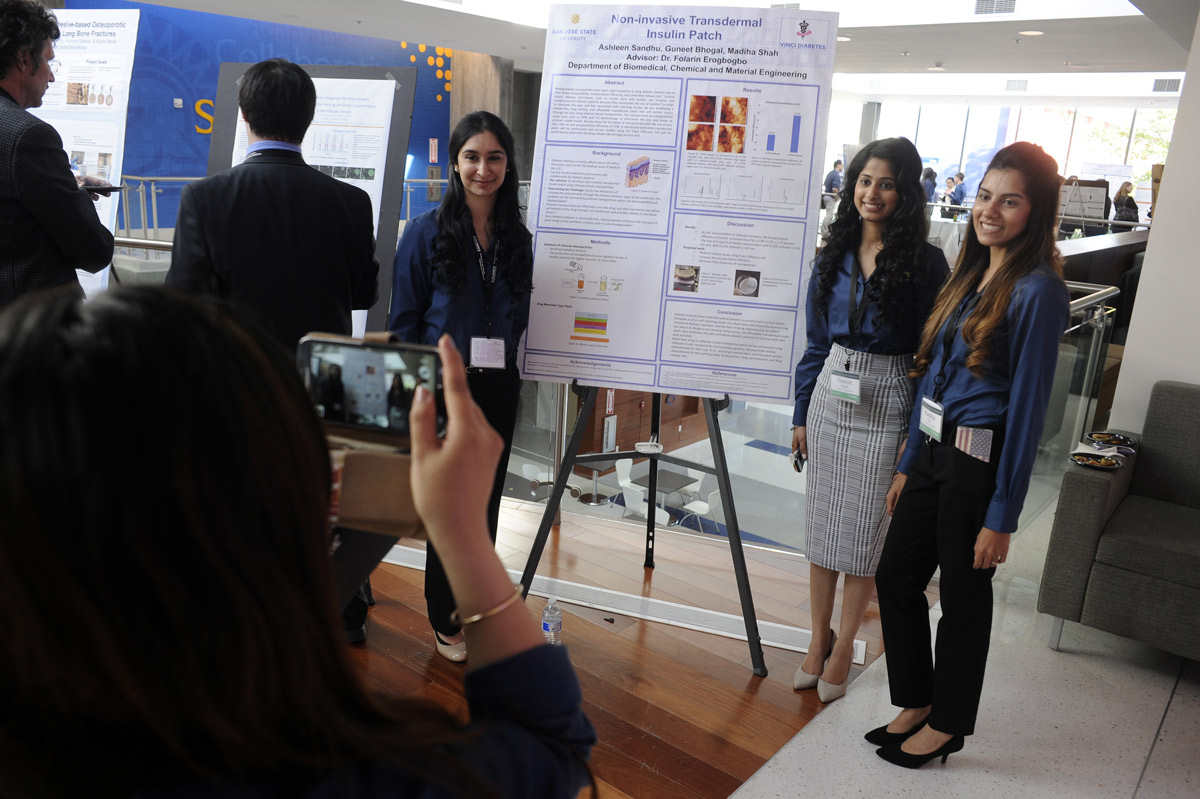
Photo: Neal Waters, ’07 Geography, ’16 MS Mass Communications
The San Jose State Biomedical Engineering Society (BMES) ushered in its Seventh Annual Bay Area Biomedical Device Conference March 30 with discussion topics ranging from unmet medical device needs in developing countries to nanotechnology and entrepreneurial guidance.
The conference, which has been student-organized by the SJSU BMES since its inception in 2010, was created to give students the opportunity to exchange ideas and network with medical device industry professionals and academics.
“As our biomedical program continues to expand, collaboration with industry partners becomes increasingly important,” said Provost Andy Feinstein. “Today’s conference is one of many ways we can work together in preparing San Jose State students to work in this growing field.”
Hanmin Lee, surgeon-in-chief of UCSF Benioff Children’s Hospital, said the more than 300 students, staff and industry professionals who filled the Student Union Ballroom all share a common interest as part of the biomedical realm — making the world a healthier place.

Olubunmi Ode (Photo: Neal Waters, ’07 Geography, ’16 MS Mass Communications).

Shanelle Swamy, ’18 Biomedical Engineering (Photo: Neal Waters, ’07 Geography, ’16 MS Mass Communications).

Photo: Neal Waters, ’07 Geography, ’16 MS Mass Communications

Photo: Neal Waters, ’07 Geography, ’16 MS Mass Communications
“Helping your fellow man is the most important thing we can do and we’re all interconnected,” Lee said. “To be able to help somebody else not only helps them but it helps you. It’s just the biggest privilege that we can all have.”
Olubunmi Ode strives to do just that, by aiding unmet biomedical needs of young children in Nigeria, a country that she says is plagued by power outages and a lack of proper medical devices.
Ode, a pediatric intensivist based in Abuja, Nigeria, has focused her life’s work on taking care of children in intensive care units through Hospitals for Humanity, a nonprofit organization that is mostly volunteer based.
“We do the surgeries and take care of the kids, but also train people on the ground so they know how to do this so we can set up the pipelines,” Ode said. “The kids do well. They survive, they go home and then come back to visit and they’re doing great.”
Shanelle Swamy, ’18 Biomedical Engineering, said she was inspired by Ode’s tales of working in inadequate medical conditions in an effort to improve Nigeria’s high child mortality rate.
“I come form the Fiji Islands and I’ve lost a lot of family members to inadequate medical conditions, hospitals that don’t have devices or just not having enough surgical rooms,” Swamy said. “Hearing about the medical needs in these developing countries is essentially what I want to work on after I graduate to really implement what we have here in the U.S. and bring it to these countries.”
Swamy, who was also a conference volunteer from SJSU BMES, said listening to the successes and difficulties of Ode and other industry professionals helped her narrow her goals as an emerging biomedical engineer.
In addition to the talk sessions, 28 student groups presented various research projects to industry professionals on posters during the networking reception portion of the conference.
Jung Han Kim, ’16 MS Biomedical Engineering, presented his research on using nanoparticles to deliver drugs that can precondition the heart to future heart attacks.
The drug delivers “small heart attacks” so that “when the real heart attack occurs, the heart is preconditioned so it can withstand the longer heart attacks,” Han Kim said.
Han Kim’s research was born from his advisor Folarin Erogbogbo, assistant professor of biomedical engineering, who is an expert in nanotechnology. Erogbogbo presented his student-collaborated findings as part of his afternoon session titled, “Nanotechnology for Biomedical Theranostics.”
“I’m part of [Erogbogbo’s] group and there are many students that are working under his advisory, so it was good for me to see where my project actually plays a role in that research.” Han Kim said. “I know that my research can also help play a big role, maybe in some ways that I don’t even know right now, in nanotechnology development.”
Erogbogbo said conferences like these are important for students to not only showcase their research, but to also engage with professionals.
“[Han Kim’s] been an excellent student, learned to solve problems and worked on a whole variety of nanoparticle synthesis techniques so it’s always great working with students like that,” Erogbogbo said. “It’s extremely important to engage in this kind of communal activity and the impression that a lot of people leave with is, ‘wow the SJSU students are really organized and impressive,’ so it’s also building our reputation here.”
